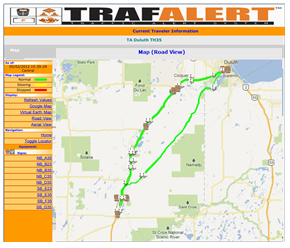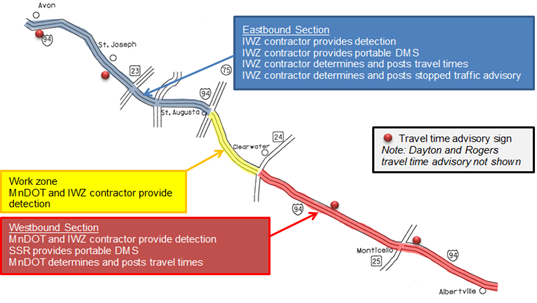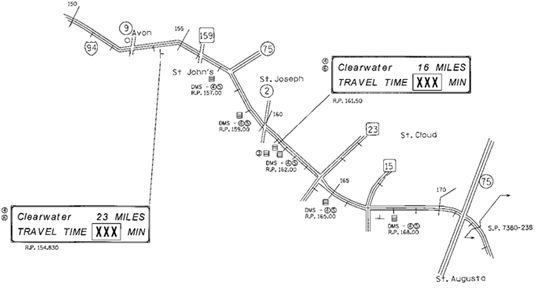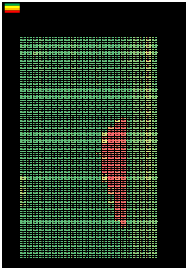Travel Time for Rural Construction Work Zones
slide 1: Travel Time for Rural Construction Work Zones
2013 Work Zone ITS Peer Exchange
May 21-22, 2013
Jon Jackels
MnDOT
slide notes:
None.
slide 2: Why provide travel time in work zones?
- Well received by the public;
- Improves travelers' experiences;
- Motorists appreciate information to:
- make route and other planning decisions,
- set their expectations, and
- reduce stress and frustration.
slide notes:
None.
slide 3: General Description of I-35 Travel Time System
- Along I-35 between Hinckley and Duluth in Minnesota
- MnDOT District 1 (Duluth)

slide notes:
None.
slide 4: General Description of I-35 Travel Time System
|
 |
slide notes:
Jon - Providing travel time and congestion information to motorists on rural freeways, especially during construction has been difficult and cost prohibitive.
I-35 - Hinckley and Duluth had three major construction projects in 2012. This project offers an innovative approach to provide travel time and congestion information along approximately 70 miles of roadway.
slide 5: General Description of I-35 Travel Time System
|
 |
slide notes:
Reed slide
This project implementation addresses requirements in the Statewide Safety and Mobility in Work Zones policy to mitigate the impacts these activities have on transportation operations. This is the initial effort to mainline these innovative IWZ systems into construction and maintenance activities on a statewide basis. This project relates to MnDOT's Strategic Directions for:
- Safety: Reduce the number vehicles going through work zones from Duluth to Banning Junction. Thus, reducing potential crashes in the I-35 work zones.
- Mobility: Reduce traffic backups and travel delay time on I-35, resulting in congestion relief and lower commute times.
- Innovation: This innovative project offers a stand-alone system in a rural application seeking to provide real-time traveler information to the motorist's for multiple construction projects spanning 70 miles on I-35 that has not been constructed before; it should be able to be used in other highway corridors.
- Transparency: Responding to the motorists' transportation needs shows the public how we value their travel time and encourages public involvement for the system performance evaluation.
slide 6: Travel Time Signs

slide notes:
Jon – This was the first time we used a new design with both distance and expected travel time on the same sign. Gives unfamiliar drivers more information.
slide 7:

slide notes:
Reed - Seven new 'Dynamic Message Signs' were installed along the I-35 corridor between Hinckley and Duluth. The signs display estimated travel times between several locations.
The signs display real–time travel information that also is simultaneously available online at http://www.trafalert.net/taduluthth35/tamap.htm Project Website http://www.dot.state.mn.us/d1/projects/i35southofduluth/
slide 8: Project Background

slide notes:
Jon and Reed
The Development of Travel Time for Rural Interstate During Construction on I-35 is a Design-Bid-Build, Destination Innovation Project utilizing Best Value Procurement, Pay for Performance and is set up as a Stand-A-Lone project.
slide 9: Stand-A-Lone Project
- Unique as it is set up as a stand-a-lone project
- Travel time contractor is also the prime contractor
- Allows direct accountability to successfully attain the project goals/deliverables
slide notes:
Jon
This project is unique as it set up as a stand-a-lone project and the travel time contractor is also the prime contractor which allows direct accountability to successfully attain the project goals/deliverables.
slide 10: Best Value Procurement
- Allows other key factors, to be considered in the evaluation and selection process, to minimize impacts, enhance long-term performance and value of construction:
- Qualifications and Experience
- Schedule
- Quality
- Performance-Based Criteria
slide notes:
Jon - Determine the pass/fail best value evaluation criteria that will be used in the procurement.
Evaluation criteria should be based on the elements that will bring the most value to the project. The following categories of evaluation criteria can be used with this approach:
- Qualifications of Personnel – Certain work tasks may benefit from personnel with specific licensure, training, or certifications. Establish pass-fail criteria based on the needs of the project.
- Experience of Personnel on Similar Projects – The personnel that will perform the work on the project should have experience on similar projects. Establish pass-fail criteria requiring minimum experience levels.
- Experience of Contractor on Similar Projects – Experience with projects of a similar size, type or complexity may benefit the project. Establish pass-fail criteria requiring minimum experience levels.
- Availability of Key Personnel, Equipment or Materials – Establish the required personnel, equipment or materials that will be necessary to successfully complete the project. Contractor will indicate availability of these items in the proposal.
- Ability to Meet Completion Date – Establish project completion requirements and request contractor completion dates.
Best value contract selection
- Any contractor may request to be qualified to bid.
- Interested contractors submit Statements of Qualifications that are reviewed by a committee (includes one Associated General Contractors of Minnesota member).
- Only the most highly qualified contractors may bid on the project.
- Bidding contractors submit a technical proposal and a price proposal.
- Contract is awarded to the "best-value" contractor as determined by dividing the price by the technical score.
- Federal Regulation CFR 635.110 (f)(1)(2003) prohibits MnDOT from favoring local firms.
- Can help identify the most qualified contractor for the project.
Jon and Reed
MnDOT PERSPECTIVE - Allowed MnDOT to select a qualified Contractor for this specialized system
CONTRACTOR PERSPECTIVE - A stand-alone contract was preferred
Previous experience criteria was too limiting and did not allow innovation for proposed systems
slide 11: Pay for Performance
- Description
- Benefits
- Drawbacks
slide notes:
DESCRIPTION
The contractor is paid for work on a graduated scale based on the quality and longevity of the work over time.
BENEFITS
- Eliminates blame when there is a problem with the quality of a specific work item
- Shifts risk of providing a quality product to the contractor
- Provides higher quality products for a longer duration
DRAWBACKS
- Time needed after project completion to ensure product performance
- Product monitoring and inspection is time-consuming
- Contractor may be required to finance a portion of the work during the performance period
Pay for Performance
Description
The contractor is paid for work on a graduated scale based on the quality and longevity of the work over time.
Difference from Traditional Method
Traditional specifications prescribe the methods and/or means of producing or constructing an item. If the contractor complies with specifications but the final outcome is not acceptable, the contractor is not responsible for corrective action.
Pay for performance specifications rely on final outcomes that can be measured against performance criteria set forth in the contract. If the contractor fails to meet minimum performance criteria, payment is withheld and corrective action is required.
slide 12: System Details in Plans and Specifications
- Performance Requirements
- Method Requirements
- Basis of Payment
slide notes:
MnDOT PERSPECTIVE
- Performance-based specifications appropriately transferred risk to the Contractor
- More detail would have increased accuracies and reduced contracting issues
- Tradeoffs exist when considering cost versus system performance
CONTRACTOR PERSPECTIVE
- Detailed plans and specifications would have transferred more risk to MnDOT
- Include a separate bid item for additional equipment (e.g. sensors) to be added if deemed necessary
- Add a disclaimer to the signs such as "estimated travel times"
slide 13: Quality Control
- Cost of Additional Requirements
- Appropriate Levels of Inspection
slide notes:
MnDOT PERSPECTIVE
- Require the Contractor to submit a plan for set-up, testing, monitoring, and correcting issues
- Keep overall costs in mind when adding additional requirements
CONTRACTOR PERSPECTIVE
- Extensive testing and validation was conducted and adjustments were made by the Contractor
slide 14: Systems Requirements Language
- Provide Clear Easily Understood Requirements
- Define Terms in the Contract
slide notes:
MnDOT PERSPECTIVE
- Define terms (especially "latency") and clarify requirements
- State that current, rather than historical, traffic data must be used to calculate travel times
CONTRACTOR PERSPECTIVE
- Definitions of terms and added clarity would help to avoid misunderstandings
slide 15: Travel Time Comparison Method
Floating Car Method

slide notes:
MnDOT PERSPECTIVE
- Describe the comparison method in the specifications
- Consider alternate methods such as video, Bluetooth, GPS, etc.
- Increase the number of comparisons for "floating car" data collection
CONTRACTOR PERSPECTIVE
- Describe the comparison method in the specifications
- The "floating car" method did not generate enough data points to create a representative sample for comparison
slide 16: Monetary Deductions
slide notes:
MnDOT PERSPECTIVE
- Consider associating deduction amounts with number of days and total project cost, rather than per occurrence
CONTRACTOR PERSPECTIVE
- Penalties for individual component failures could motivate the use of fewer components (e.g. more sensors increases likelihood of deductions)
- Only penalize travel times that are out of specification, not individual system components
slide 17: Project Website
- Required by Contract
- Linked on Mn511 Website

slide notes:
MnDOT PERSPECTIVE
- The password-protected function of the website provided a helpful tool for MnDOT to check on issues and view archived data
CONTRACTOR PERSPECTIVE
- Link to the project website was difficult to find on MnDOT's 511 website
- Consider full integration of the project website into MnDOT's 511 website
slide 18: Staff Training and Technology

slide notes:
MnDOT PERSPECTIVE
- This was the first time MnDOT deployed a travel time system along a long (70 miles) rural freeway segment
- Plans and Specifications did not previously exist
CONTRACTOR PERSPECTIVE
- Because technology changes at a fast pace, it is difficult to maintain expertise in managing and testing these types of systems
- It would be beneficial for the MnDOT staff to have training on current technologies and practices before bid documents are developed
slide 19: Public Feedback

slide notes:
MnDOT PERSPECTIVE
- Input via the public survey was positive, overall
- Motorists appreciated having travel time and alternate route information
- Number of emails reviewed by the Evaluation Team with negative feedback was relatively low
- Motorists indicated that the sign at Hinckley should have been placed south of the exit so northbound travelers could exit after seeing the travel time
CONTRACTOR PERSPECTIVE
- Should be included in weekly meeting
- Contractor needs to know so they can respond.
slide 20: System Performance

slide notes:
MnDOT PERSPECTIVE
- The system performed with a high degree of accuracy in free-flow traffic conditions
- Most inaccuracies occurred during transitions to congested conditions
- Only 5% of instances that compared actual vs. displayed travel times were not within the accuracy values specified
CONTRACTOR PERSPECTIVE
- The system performed with a high degree of accuracy
- Consider specifying additional signs, to increase accuracy at each sign
slide 21: Project Goals and Indicators of Success
- Provide travel time & congestion information to motorists on rural freeways
- Utilize an innovative approach
slide notes:
MnDOT PERSPECTIVE
- Travel time accuracies were generally acceptable to the public
- The system fulfilled a need identified by the public to provide information about travel times and alternate routes
- The MN-23 alternate route was not utilized as much as desired
CONTRACTOR PERSPECTIVE
- Nice to know what it was but did not get this. Should have during project.
- We assume everything is good when we are not being fined.
- More feedback before penalty.
- Needs better definition and communication during project.
slide 22: Eastbound I-94 Intelligent Work Zone

slide notes:
None.
slide 23: Eastbound I-94 Intelligent Work Zone

slide notes:
None.
slide 24: Westbound I-94 Intelligent Work Zone

slide notes:
None.
slide 25: Questions?
Jon Jackels
MnDOT
(651)234-7377
Jon.Jackels@state.mn.us
http://www.dot.state.mn.us/guidestar/index.html
slide notes:
None.
slide 26: I-94 Speed Data

slide notes:
None.
Return to List of Presentations